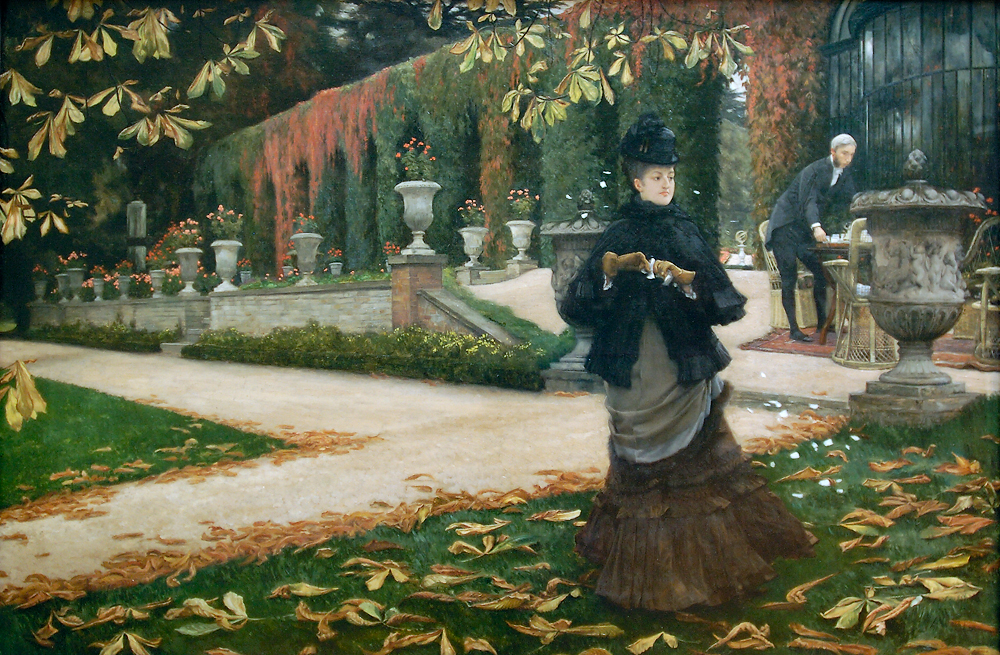
Picture this: the glittering heights of Second Empire France and Victorian London. A young man cast out by his father for studying art. A beautiful muse who dies of consumption. Forays into Séances to make contact with the departed beloved. It sounds like the makings of a fine (and dare we say, juicy) BBC period drama, but actually, it’s all part of the life of French artist James Tissot, the subject of the Legion of Honor’s latest special exhibition put on in conjunction with the Musée d'Orsay in Paris.
Tissot (1836-1902) was an acclaimed artist during his own lifetime whose celebrity has faded since his death. While most people today may recognize Realists like Courbet and Millet, Impressionists such as Manet and Degas, and Pre-Raphaelites like Millais and Rossetti, Tissot seems to have largely slipped through the cracks, partly because he doesn’t conform to any particular school. Instead, his work is an amalgamation of all those influences and more, and comprises a variety of subjects that changed over the course of his career. Interestingly, what we consider his most iconic work today is not what brought him international fame and prestige in his own time.
His best known paintings today are those from his middle career, which often contain one or more of the following elements: Debutantes in decadent dresses, dandies with magnificent mustaches, elegant parties, and of course, the perennial pug. You may have seen them gracing the covers of novels by Edith Wharton and John Galsworthy. Set in contemporary society, these paintings are thoroughly modern because they look at people of Tissot’s own time, evaluating their social mores and fashions as if through the eyes of a sociologist, often with more than a twinkle of satirical observation.
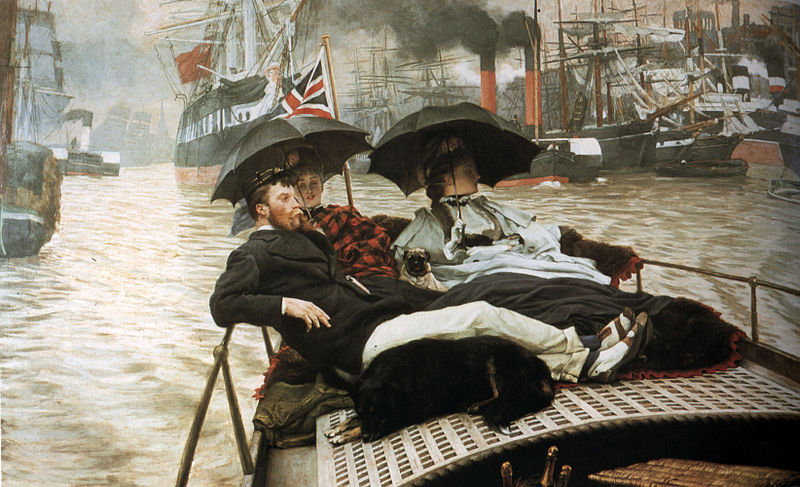
The Thames, James Tissot, 1876, Private Collection.
Wait, are those three bottles of champagne? One for each of these young people? Where is their chaperone? And what is that smutty atmosphere supposed to say about their activities?

Born in Nantes to a family of drapery merchants, it is believed Tissot picked up his obsession with textiles and meticulous detail in his family’s shop. While his father opposed Tissot’s plans to become an artist, he set off for Paris anyway with the help of his mother. He studied under a pupil of the great French Academic Jean-Auguste-Dominique Ingres, whose rich color, fine contours, and exquisite portraiture are discernible influences in Tissot’s work. The young artist debuted with a rather anachronistic style, creating medievalized and sixteenth century-style paintings in the style of Henri Leys that were outmoded even when Leys was making them.
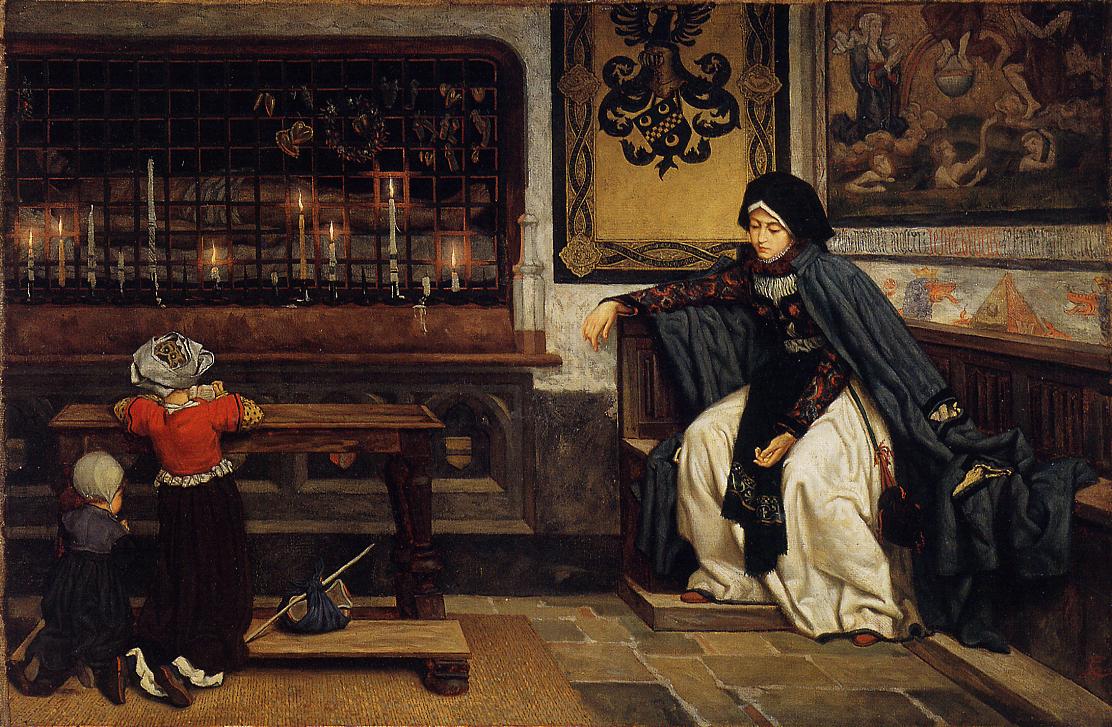
Marguerite in Church, James Tissot, 1861, National Gallery of Ireland.
With an eye for what would actually sell, Tissot quickly changed course from these grand medievalisms and turned to more modern subject matter. Indeed, at first glance, his work changed so much you might think it was by a different artist altogether. The man was a chameleon, whose style changed with the market. And yet, these early paintings showcase what would become dominant threads throughout all of his work: richness of clothing and material goods, a sense of narrative, keen interest in behavior and body language, nuanced expressions, and a uniform degree of detail across the entire picture. As you walk through the rooms of the exhibition, which are arranged chromothematically, you can always trace these elements of his work, no matter how much it changes.
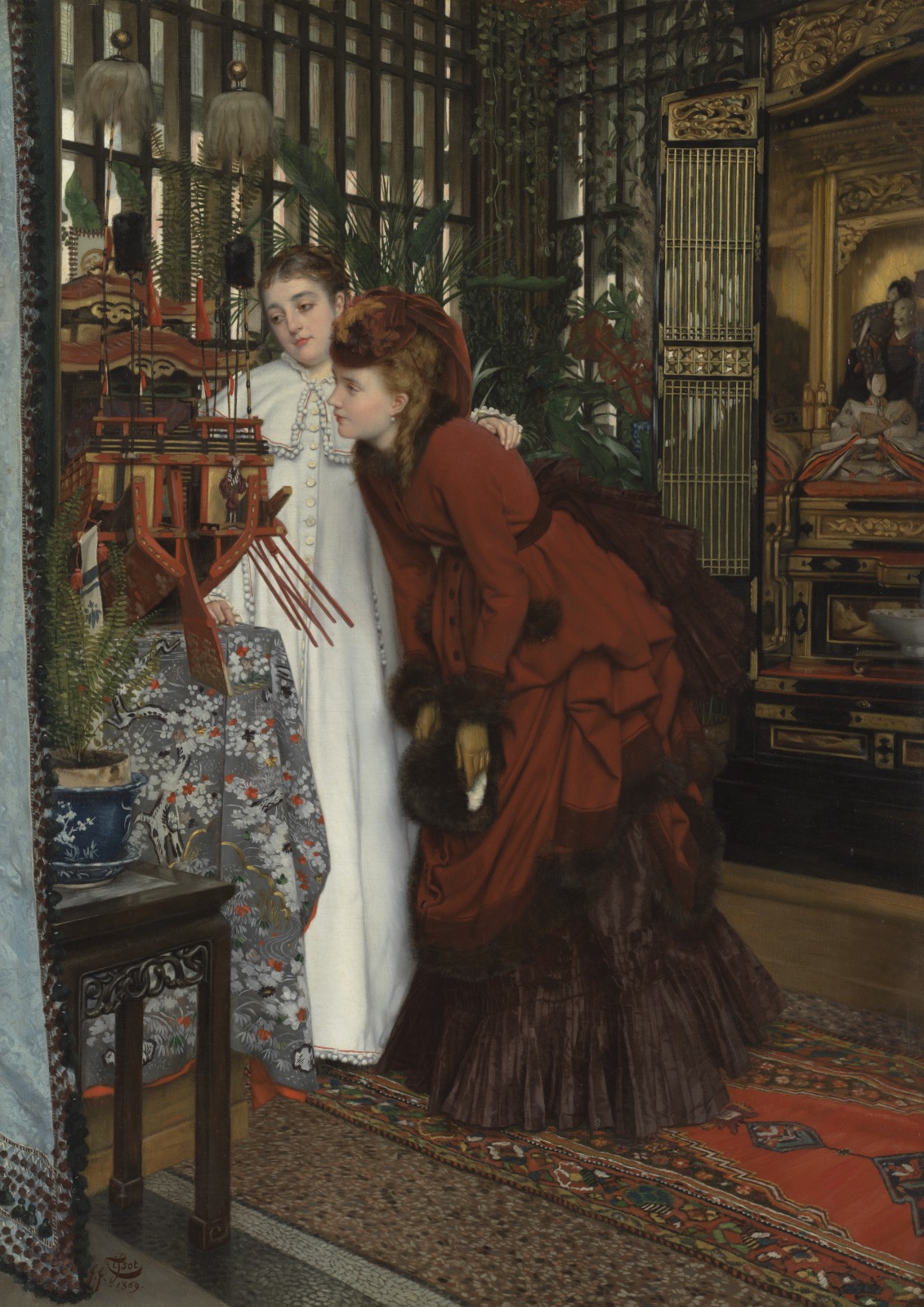
Young Women Looking at Japanese Objects, Tissot, 1869, Cincinnati Art Museum.
Unlike other idiosyncratic artists, Tissot was very successful in his own lifetime, raking in the francs even as a young man. Naturally, portraits were a great way to get commissions, and the curators of the exhibition point out that sometimes Tissot may have disingenuously labeled his paintings as portraits in order to drive commissions his way. However, these images are where he truly shines, blending portraiture and genre, and somehow channeling both Whistler and Ingres.
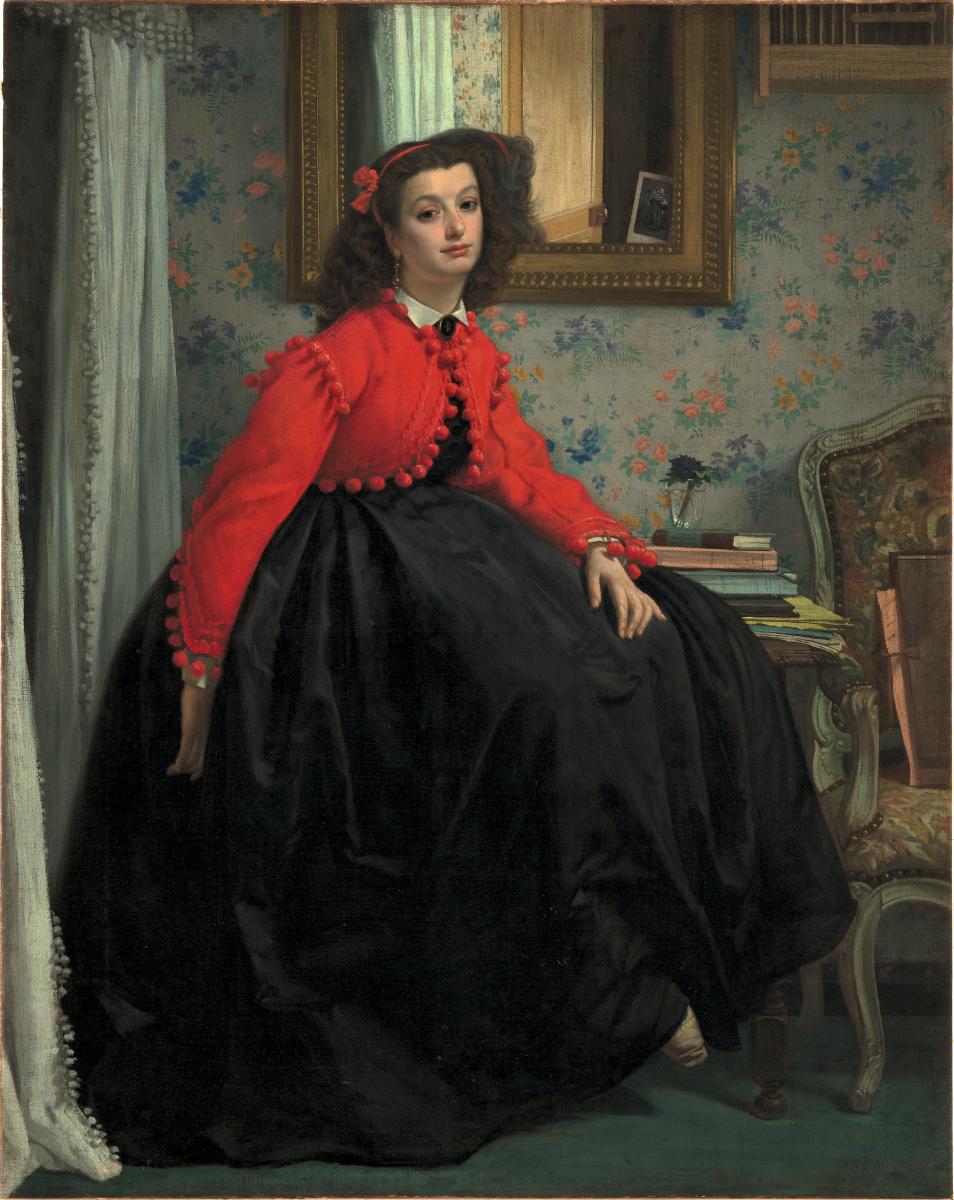
Portrait of Mademoiselle L. L., Tissot, 1864, Musée d'Orsay.
No one knows who this L. L. is, which leads some to speculate that this may be one of those pseudo-portraits. But by the looks of her she’s one radical woman! A bold gaze, a bright red bolero jacket, a hint of a blue stocking, and a pile of well-read books. Definitely BFF material.
Tissot was pals with a number of the budding impressionists, and even fought alongside them during the Franco-Prussian War. In fact, Degas was once disgusted with him for sketching the body of a fallen artist comrade rather than immediately retrieving it. The complicated situation in Paris after the war ended put Tissot in an awkward political position, so he dashed across the English Channel and bought a house in London, certain he could break into their art market successfully. This is when he produced much of his iconic work, paintings of soirees, boating outings, and tea parties, quintessentially English scenes following in the tradition of conversation pieces like those by Reynolds and Hogarth. He knew those nostalgic English would eat those right up with their scones and clotted cream.

What Tissot might have looked like trying to blend in in England.
But alas, while Tissot continued to be successful, he was met with some distrust. Were his satirical images benign jabs at general human behavior, or actually snide comments about the English themselves? Critics gave him mixed reviews. If there’s one thing that can unite the French and English, however, it’s mutual disdain for Americans.

London Visitors, Tissot, 1874, Toledo Museum of Art.
In his London Visitors, we see a man and alluringly dressed woman (probably Americans) standing on the front steps of the National Gallery. Visible behind them, the clock tower says the time is 10:30. The museum famously opened at 10 am, meaning that this tourist couple, facing away from the museum and consulting a guidebook, has already been through the entire museum in only half an hour! To have so much money but be so uncultured is truly American. Furthermore, that cigar on the steps indicates the presence of a man out of view, a man who has attracted the shameless attention of this brazen woman. Thus, leaving clues like the cigar and clock, Tissot humorously conjures up an entirely believable society scenario.
It was the same year that this was painted that Degas invited Tissot to participate in the first Impressionist exhibition along with himself, Manet, Monet, Renoir, Pisarro, and Morisot. Like the impressionists, Tissot eschewed Academic and Classical subject matter and instead painted modern life. Also like the Impressionists, he painted with visible brushstrokes, not the invisible ones of Ingres. And yet, Tissot declined. He was no Impressionist, in terms of content, method, or style. Standing before his works in the exhibition, you can see his hard contours, bold colors, and narrative content, so different from Pisarro or Morisot. He’s sometimes called a hyper-realist, and yet that doesn’t feel right, either. From far away, his works look very finely detailed, and yet close up, the brushstrokes are too lively, the varnish too exuberant, to be called realistic at all. His brushwork is completely unique and utterly marvelous, and viewing it in person is definitely one of the pleasures of this exhibition.
When he was in London, Tissot met and fell in love with Kathleen Newton, an Irish divorcée whose divorced status prevented her from marrying again. With her thick red hair, heavy-lidded eyes, and scandalous status as unwed mother, she captivated TIssot, who set up house with her and her children and painted her again and again. She is the iconic Tissot female, alluring and fashionable but also gentle, often gazing into the distance. Tissot considered their time together one of domestic bliss. But bliss it would not be for long. She contracted Tuberculosis, what the Victorians referred to as consumption, and her health slowly unraveled. She died in 1882 at the age of 28.
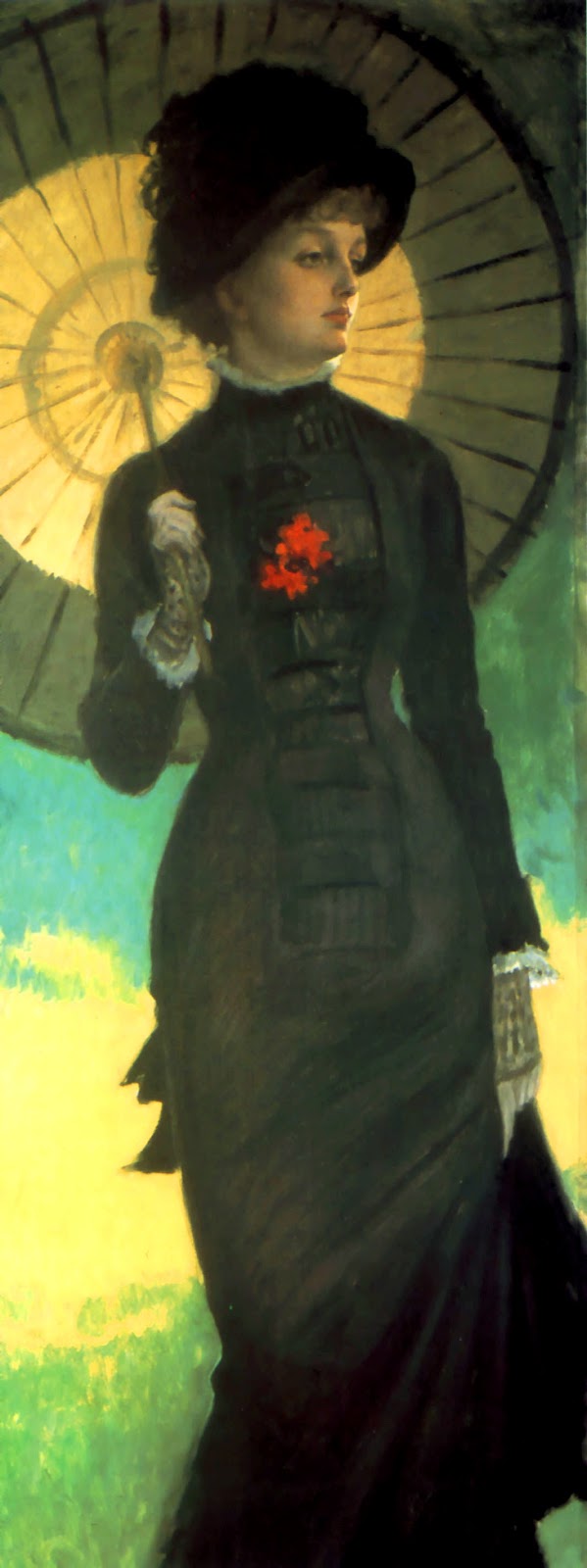
Mrs. Newton with a Parasol, Tissot, 1878, Musée Baron Martin.
One of the exhibit’s strongest veins is its handling of this love story, juxtaposing his grand canvases starring Kathleen in elegant society settings with the more intimate pictures of home, where she is surrounded by her children. In these latter images, the spectre of death closing in can be detected in her resting figure, her heightened features, the circles under her eyes, and the darkened interiors even when the sun is shining outside. The exhibit traces this love story well, and perhaps that helps lend emotional force to the subject of curator Melissa Buron’s extensive Ph.D. research: Tissot’s later work, which he could only have created after an experience with Death.

After Newton’s death, the devastated Tissot returned to Paris and began attending séances in an attempt to contact her. Like many people of his day, he was caught up in Spiritualism (called Spiritism in France), a movement that tried to scientifically prove the existence of the afterlife with things like slate writing and table rapping. And the spooky thing is that with the help of British medium William Eglinton, the deceased Kathleen Newton, accompanied by a spirit guide, did materialize for Tissot at a séance in London, or at least, that’s what everyone who attended said happened. Tissot immediately made a painting of this ghostly apparition, and it’s on display now at the Legion’s exhibit for the first time in decades.
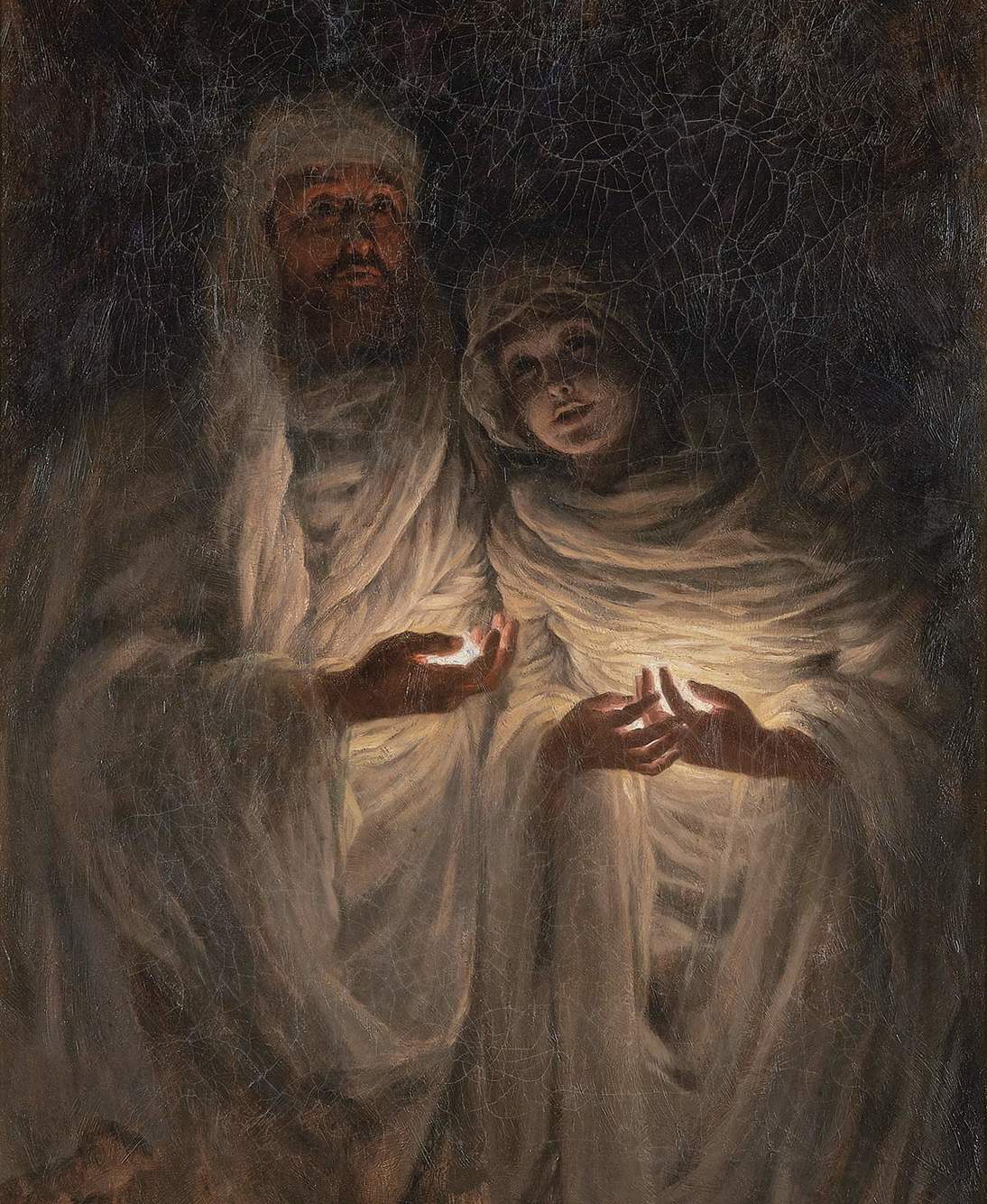
The Apparition (detail),Tissot, 1885, Private Collection.
This obsession with the Paranormal was complemented by another vision Tissot had, this time in the Church of Saint-Sulpice in Paris in 1885. At the moment of transubstantiation, when the priest holds up the consecrated bread and wine during mass, Tissot beheld a vision of Christ consoling a couple. Tissot’s vision is in keeping with the resurgence of Catholic Mysticism in France at the time, and it is worth noting that Spiritualism, despite its interest in the Occult and alternative belief systems such as those of Ancient Egypt, was completely reconcilable with Christianity to Tissot.
Perhaps he was capitalizing on the spiritual Zeitgeist of his time, but it’s clear that these incidents sparked a drastic change in his work. While he had been painting monumental images of the fashionable ladies of France (to prove he hadn’t gotten too English while abroad), he suddenly switched course and embarked on a series of small, deeply felt watercolors depicting scenes from the New Testament. When complete, these watercolors traveled the world and earned him celebrity status. Women reportedly fell before them and wept, and people even crawled from picture to picture on their knees in prayer. These watercolors are remarkable for their Symbolist intensity and cinematic quality, anticipating novel vantage points that would be seen in later films (all the way up to Mel Gibson’s “The Passion of the Christ”).
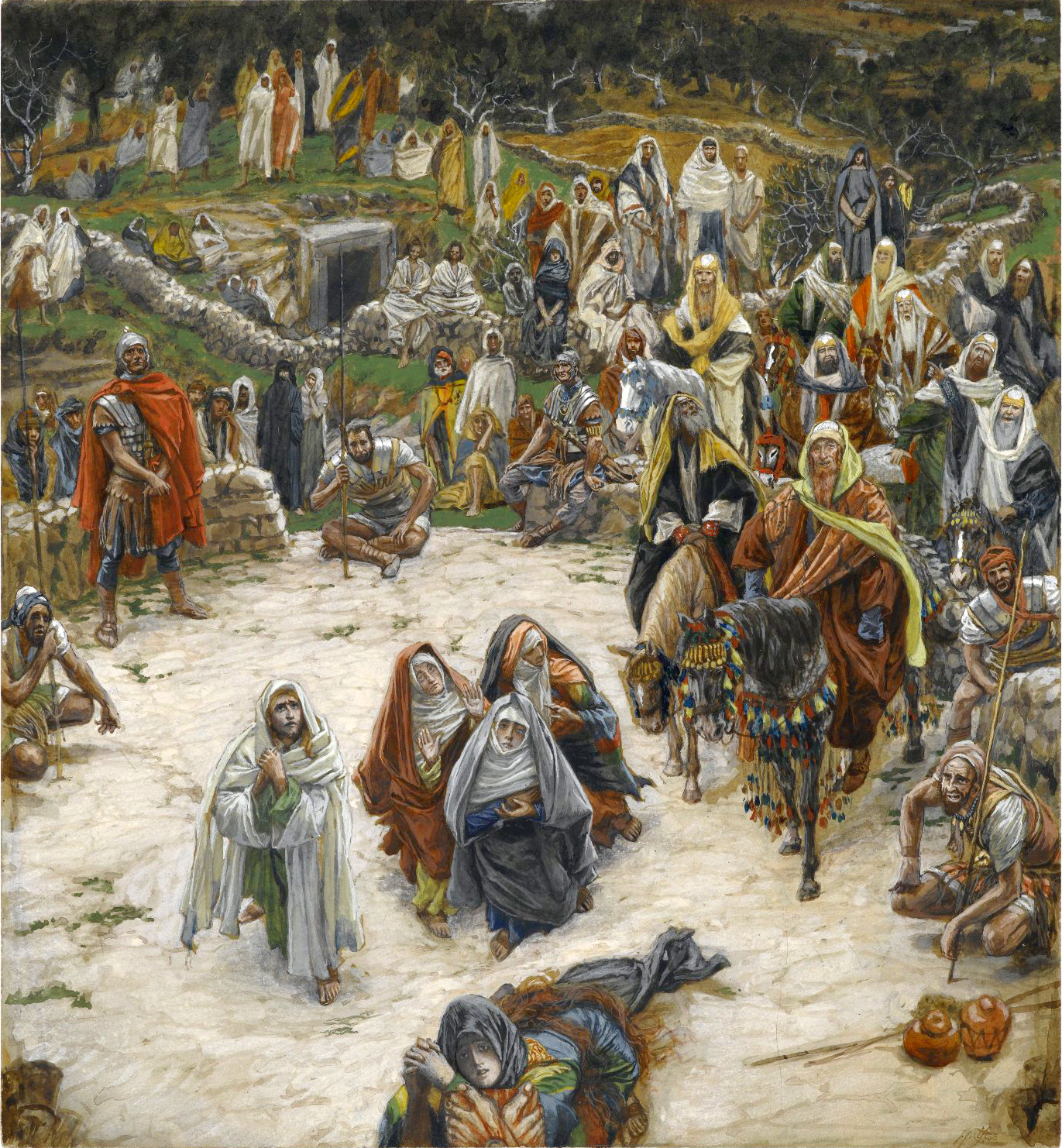
What Our Savior Saw from the Cross, Tissot, ca. 1886-1894, Brooklyn Museum.
And in some ways, despite being so very different from works like London Visitors, you can still see the Old Tissot shining through in his meticulous attention to detail, his accuracy of dress and setting (he actually traveled to the Holy Land to do research), and his skillful rendering of nuanced expressions and narrative. Up until his death, he also worked on a series of the Old Testament. One fun tidbit: his rendition of the Ark of the Covenant served as the inspiration for it's appearance in Indiana Jones.
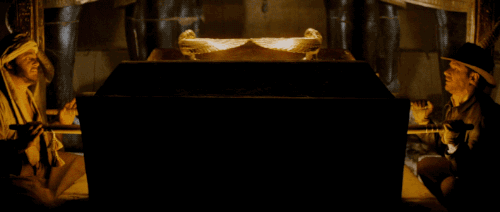
That’d be this bad boy right here. Lifted straight outta Tissot.
This lovingly curated exhibit is rounded out by some truly splendid cloisonne enamels by Tissot and a fascinating inquiry into the attribution of a mysterious study of a man with his back turned in the Legion’s collection. Also of interest are two series of paintings of the Prodigal Son, one from Tissot’s earlier period set in Medieval Europe, and the other set in contemporary days, with his own pops figuring as the father in the parable. Facing each other across three rooms in the exhibition, they frame the show nicely, chronicling his progress as an artist, but also painting a picture of his own private hopes and relationships.
The show is very personal, painting as intimate a portrait of Tissot as may be possible. The problem is that he’s just so mysterious. He was a man entirely of his own time, and so was his work, but while his images are dazzling, you often find yourself wanting more. Some statement beyond the vaguely moralizing or satirical. And until he went on his Bible kick, it’s difficult to perceive what that might be. After all, how do you reconcile the overtly materialistic with the spiritually meaningful? Perhaps it is true that, as Nancy Rose Marshall suggests in the catalogue, even in his present day images, the objects surrounding his figures are meant as a portal to something higher, a “vehicle for contemplating the invisible realms,” in much the same way that the Symbolists and Pre-Raphaelites used them. Mundane objects could lead to spiritual truths, and maybe Tissot had been working on a spiritual project all along.
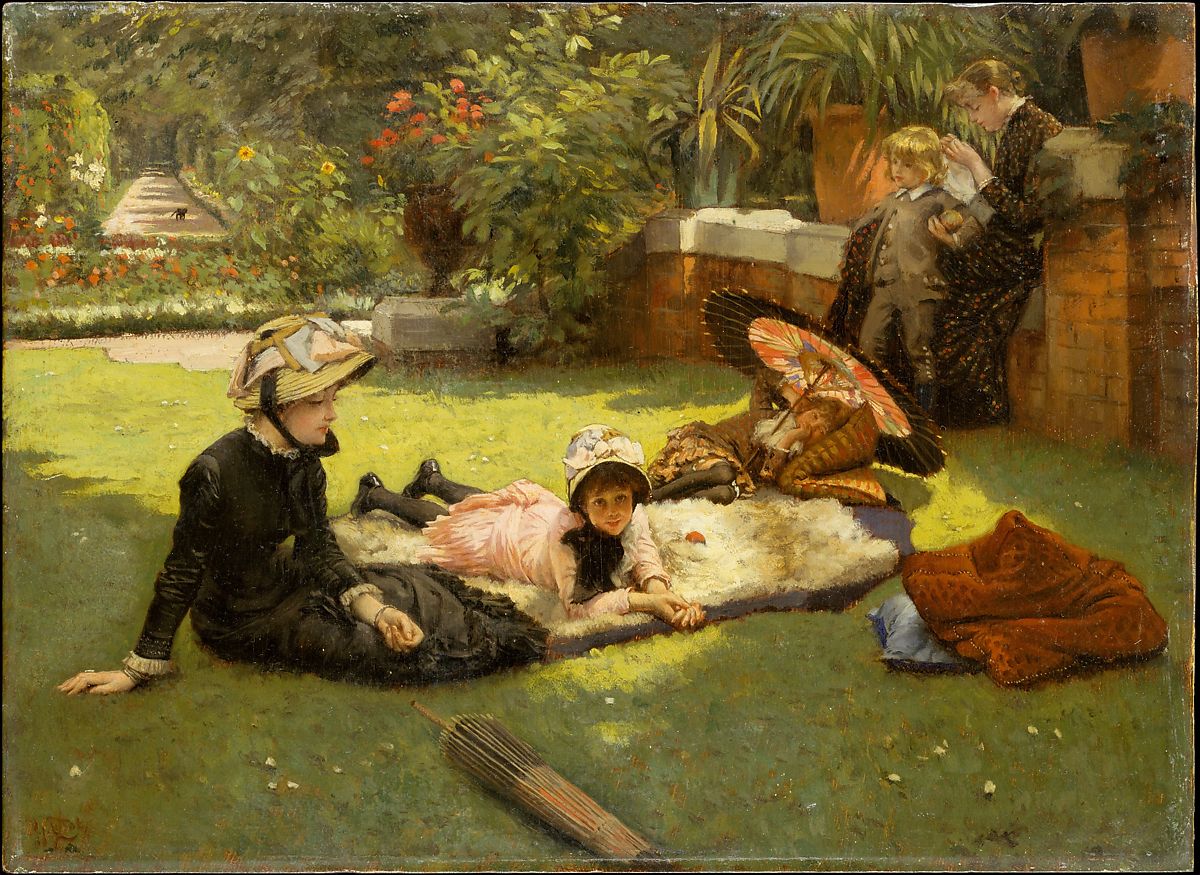
In Full Sunlight, Tissot, ca. 1881, Metropolitan Museum of Art.
Either way, Tissot is relatively little known today among the general public. Curator Melissa Buron suggests some possible reasons for this. The first is that he had no children to champion his legacy. The second is that he truly is uncategorizable, impossible to lump in with any movement. Thirdly, both his religious and his fashionable imagery fell out of style in the 20th century. It’s possible, too, that his very commercial success is a bit of a turn-off. Sometimes it’s the struggling pioneers like Vincent Van Gogh that feel more deserving of our attention. Nevertheless, anyone remotely interested in 19th century culture or just exquisite painting technique will find much to enjoy in Tissot’s work.
The Catalogue is tremendous, luxuriously bound in green and gold and brimming with original essays that tackle everything from his childhood in Nantes, to his sorties in the Paranormal and his influence on film. There is fresh scholarship as well detailing his painting methods and his own ledgers of painting sales. If you can’t make it to San Francisco to see the exhibit, the catalogue is a solid, beautiful substitute. It makes a worthy addition to any art history or Victorian studies aficionado's shelves. Find it on amazon here. (paid link)
For petticoats and parasols, a tragic love story, and an enigmatic artist, “James Tissot: Fashion & Faith” is sure to delight. And when you’re there, don’t forget to count the pugs!

“James Tissot: Fashion & Faith” can be seen at the Legion of Honor until February 9, 2020. You can find more information here.
Sources
- Buron, Melissa, editor. James Tissot. New York: Prestel, 2019.










What an incredible man!